- Drive traffic to your business.
- Increase awareness of your brand and products.
- Bring new customers your way.
- Educate and nurture your customers and prospects.
- Help you become a thought leader in your niche.
We say “can” because you first need a bulletproof blog content strategy for your blog to tick all of these boxes.
And that’s what we’re going to talk about today.
Here’s what we’ll cover:
- What is a blog content strategy?
- Why do you need a blog content strategy?
- How to create a blog content strategy
A blog content strategy is a vision and a plan that you have for your blog. Much like a business strategy, a blog strategy will point your blog in the right direction and guide you towards what you want to achieve with your blog content.
Your blog content strategy should be aligned with your business goals and your overall content strategy. Your business goals should be the main driver of your content.
For a better idea of where your blog strategy sits in the big picture, here’s a simple diagram:

There are more than seven million blog posts published every single day. In our study, we found that the majority (90.63%) of all web pages get no monthly organic traffic. At all.
Without a clear strategy, you might end up creating blog content for the sake of creating it—without it getting any traffic and doing any good for the growth of your business.
A solid blog strategy will help you be in the 9.37%.
Now, let’s get to creating one.
Here’s a step-by-step guide for building a blog strategy that will help you get more traffic to your business and bring new customers your way.
- Define your “why”
- Research your competitors
- Do thorough keyword research
- Build a content plan
- Create your blog’s identity
- Track your success
1. Define your “why”
Forget the metrics for a moment and think of the big picture. What is the purpose of your blog? Why should your blog exist? Your answers to these questions form the essence of your blog content strategy, so try to put it into one sentence and let it guide all your blog efforts.
At Slido, for instance, our overarching goal is to become the #1 resource for those who want to run better meetings.
If you’re struggling to find your blog’s purpose, this simple “help-to-by” framework (inspired by the “get-to-by” model from advertising) may help you. Just fill in the gaps.
The purpose of my blog is to help [audience with a specific problem or JTBD] to [the desired outcome] by [the means].
At Ahrefs, our help-to-by strategy could be as follows:
Help marketers and website owners to get better at SEO and drive more traffic to their websites by publishing in-depth tutorials and how-to guides.
If you’re building a blog for your online yoga accessory store, your blog’s purpose may be to:
Help people starting with yoga to reach success by providing them with the best practices and the best tips for equipment.
It’s crucial to set your “why” right off the bat as it helps keep every other aspect of your blog content strategy on track.
2. Research your competitors
Competitive research is an invaluable source of inspiration for your blog content. It uncovers which keywords bring them traffic, what type of content works for them, what they’re doing well, and where they fall short.
You should research two types of competitors:
- Business competitors
- Content competitors
Business competitors
Business competitors are the companies/brands that offer similar (or the same) products or services as you do. They’re relatively easy to identify, as you’ve probably been aware of them from the very beginning of your business.
For example, if you’re selling yoga mats, then liforme.com is your business competitor.
You can check your competitor’s best-performing content in organic search using Ahrefs’ Site Explorer:
- Enter their domain or blog
- Go to the Top Pages report

Here, you can see that liforme.com gets a lot of organic traffic to their posts about seated yoga poses and yoga poses for flexibility. They also rank #1 for both of these keywords in Google, as you can see from the “Top Keyword” and “Position” columns.
This report is great for quickly finding some initial topics and keywords that might be worth writing about. If you need more, just repeat the process for more business competitors.
Content competitors
Content competitors are websites you’re competing against in organic search but that don’t necessarily compete with you in a business sense.
For example, one of our content competitors is backlinko.com because it competes for many of the same keywords. But it’s not our business competitor because we both sell different things.
You can find content competitors easily with Keywords Explorer:
- Enter the keywords you found when analyzing business competitors
- Go to the Traffic Share by Domains report
This report shows the websites with the most estimated organic traffic from the keywords you entered:
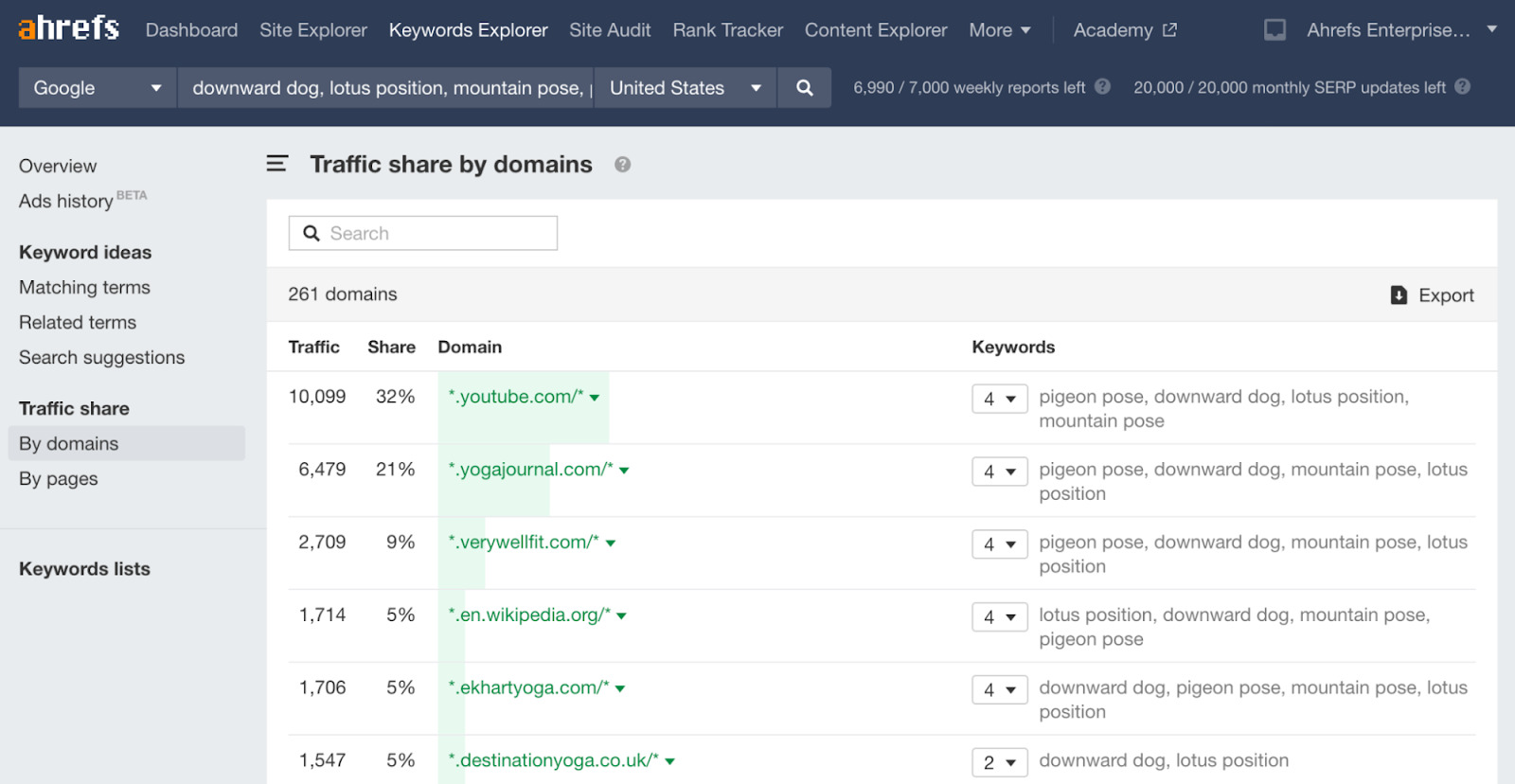
Run these sites through Site Explorer as you did with your business competitors to find even more topic ideas.
3. Do thorough keyword research
Now that you know what your competitors write about and where their traffic comes from, it’s time for keyword research to explore what people are searching for in your niche.
First, identify your seed keywords. Seed keywords are basically the key topics that you’ll be writing about on your blog. The easiest way to do this is to write down the main words that define what your business is about or what you sell.
For example, if you’re starting a blog for your coffee shop, they might look something like this:
- Coffee
- Espresso
- Cappuccino
- Latte
- Aeropress
- Coffee beans
If you plug these into Keywords Explorer, go to the Matching terms report, and switch the match type to “Questions,” you’ll see hundreds or thousands of question-focused keyword ideas:
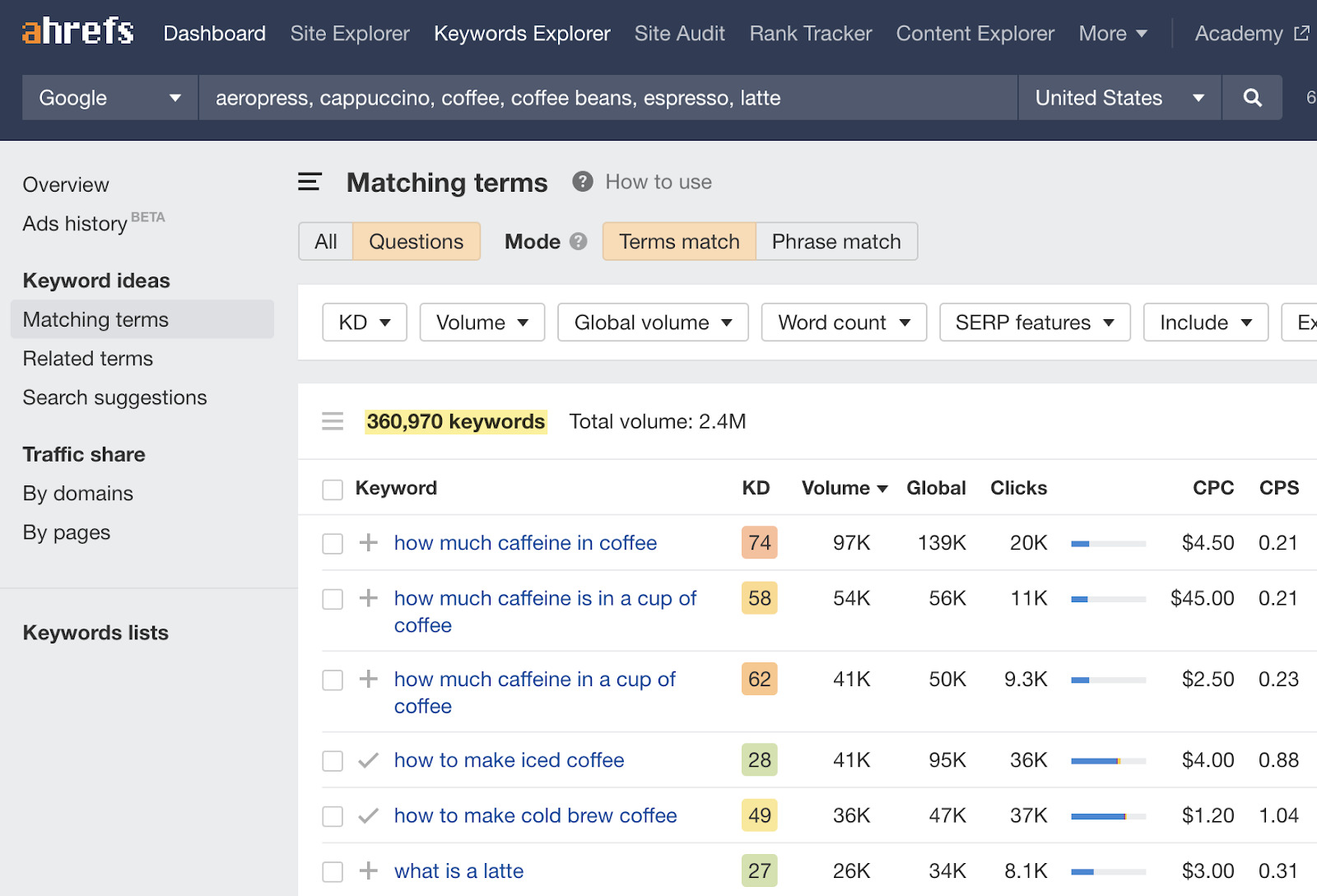
Most of these will be suitable candidates for blog posts because they’re questions.
If you need more keyword ideas, read our full guide to keyword research.
4. Build a content plan
Now that you have tons of ideas for your blog, it’s time to prioritize and build your content plan. To do this, you should consider these three metrics:
- Traffic potential – How many times a month is that keyword searched for in Google?
- Ranking difficulty – How hard is it to rank in organic search results for that keyword?
- Business value – How relevant is your product in connection to the topic?
The best topics are those with high traffic potential and business value and low competition:

How do you judge these things?
In Keywords Explorer, you can get a rough sense of traffic potential by looking at the keyword’s monthly search volume. However, we recommend paying more attention to the estimated traffic of the top-ranking page—as most pages get traffic from multiple keywords.
For example, the search volume for “how to make french press coffee” is 20K/month, but the top-ranking page gets around 60% more traffic:

As for estimating ranking difficulty, our Keyword Difficulty (KD) metric is a good first port of call. It rates the relative ranking difficulty of keywords on a 0-100 scale (higher = harder):
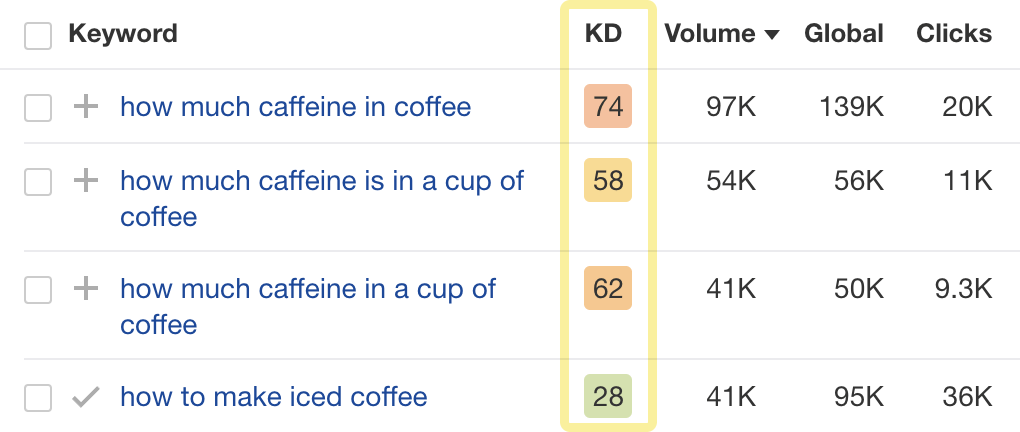
That said, as it’s impossible to distill ranking difficulty to a single number, we recommend you check a few other things before targeting a keyword. You can learn more about those in our guide to finding low-competition keywords.
Finally, when it comes to business value/potential, we recommend assigning each topic a value between zero and three depending on how important your product/service is for solving the problem at hand.
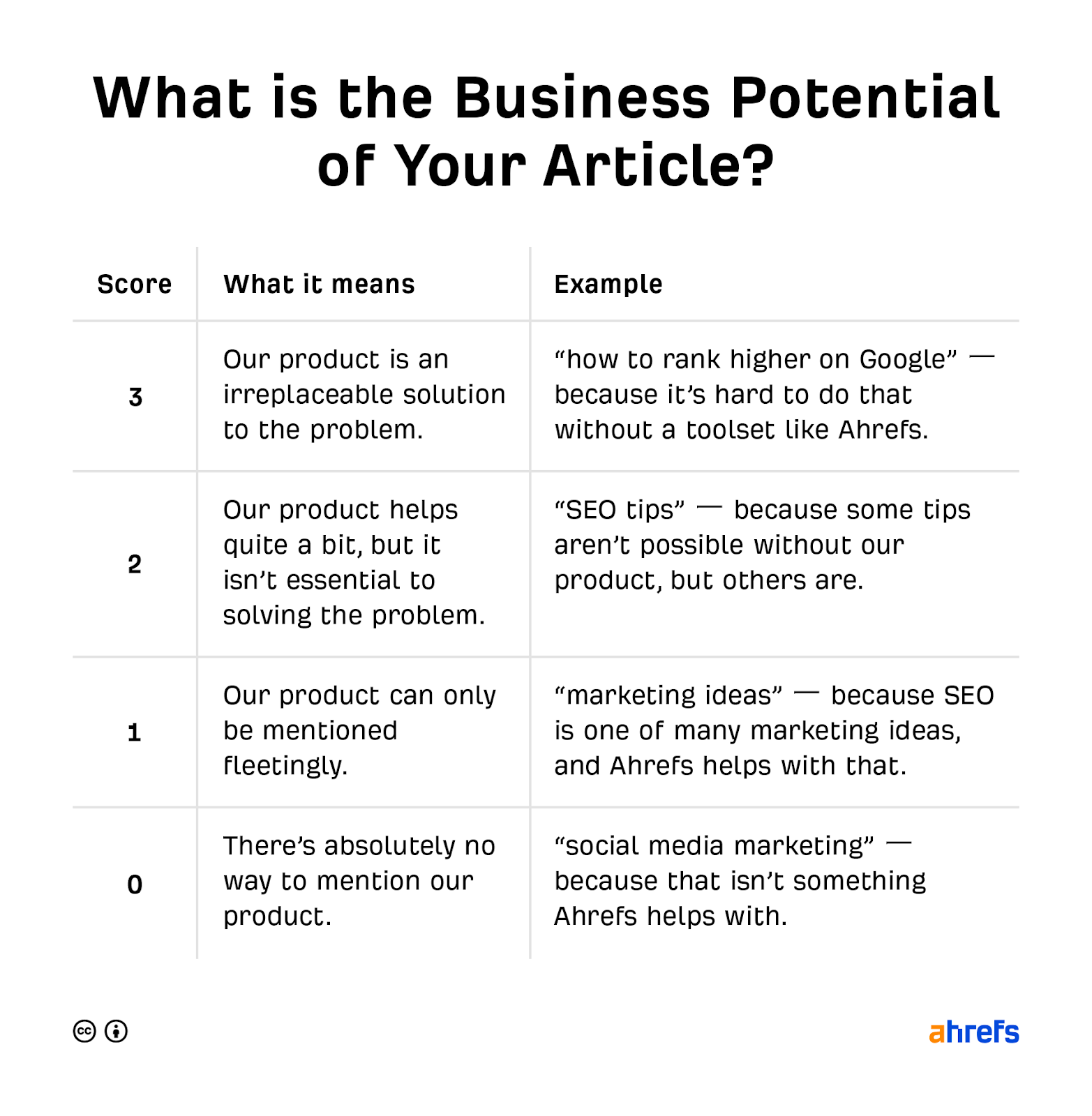
Bringing this all together, it’s clear that if you sell high-quality coffee beans online, then a keyword like “how to make iced coffee” should be on your radar because it:
- Has high traffic potential – the top-ranking pages gets ~46K monthly search visits.
- Is low competition – its KD score is relatively low (28), and some of the top-ranking pages are from relatively small sites.
- Has high business value – your coffee beans can help searchers make a better cup of iced coffee.
Once you’ve found a bunch of relevant topics to cover, the next step is to group your topics and tackle them in batches, otherwise known as “clustering.”
For example, when doing keyword research, you might notice that many people are searching for ways to make different types of coffee, like:
- how to make iced coffee
- how to make cold brew coffee
- how to make french press coffee
- how to make whipped coffee
- how to make matcha latte
So it might make sense to group these into a “cluster” and tackle them simultaneously. You may even be able to use the same template/outline for all topics in a group, which will significantly improve the efficiency of your content creation efforts.
You can also interlink these posts to create what’s known as a content hub, which some people believe helps each post to rank higher in Google:

5. Create your blog’s identity
Think of your blog in the same manner as you think of your brand. What differentiates it from other similar blogs? What will be your blog’s distinctive voice, tone, and style?
Put together a set of editorial guidelines that will define your blog’s style.
The most important aspects of your blog’s guidelines are:
- Visual guidelines
- Voice & tone
- Writing rules
Visual guidelines
Visual guidelines are there to create consistency in the quality and style of blog post imagery. It’s important because your blog is an extension of your brand, so you shouldn’t underestimate the visual side.
There’s often a lot to consider here, so a good starting point is to find a way to make your header illustrations distinctive and recognizable.
For example, on the Ahrefs blog, each post features a custom illustration with a unique visual style:
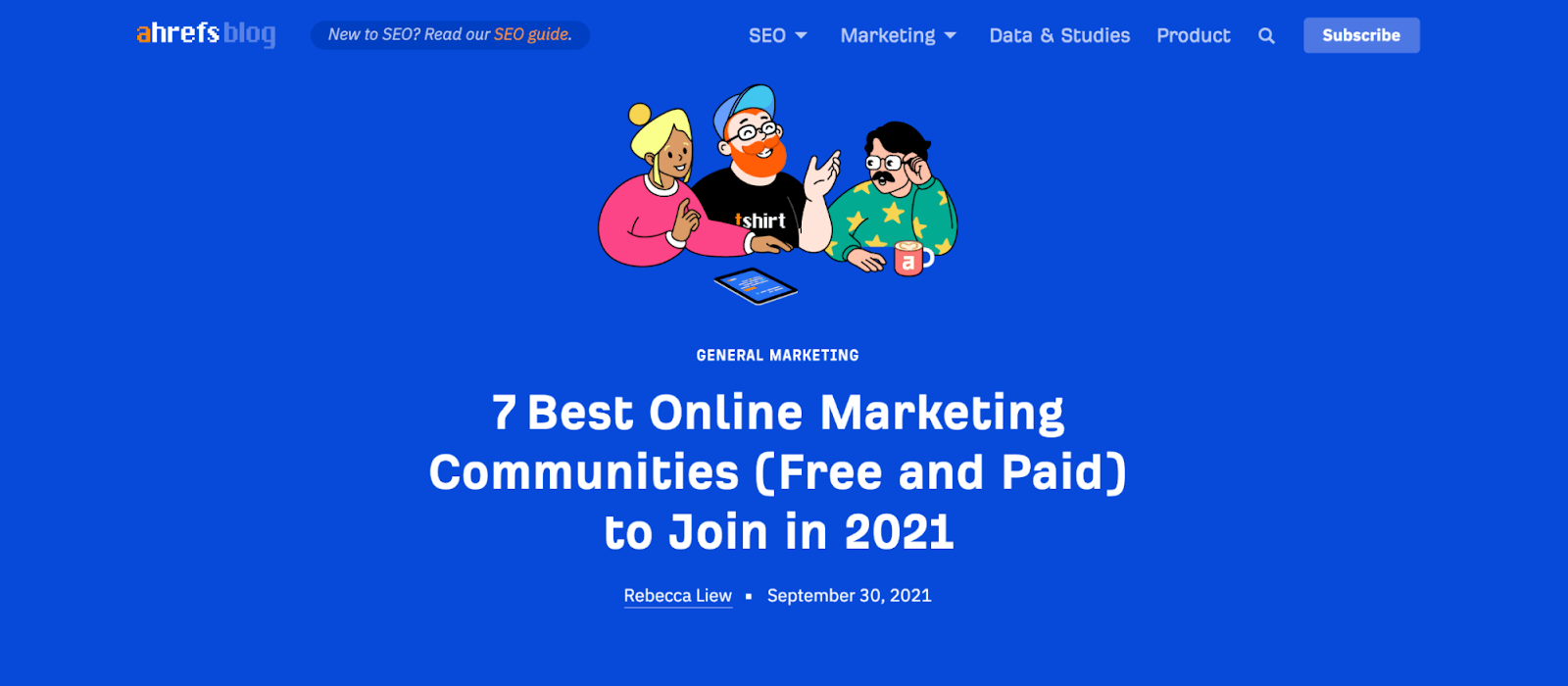
Voice & Tone
Voice and tone guidelines define your blog’s personality and values. For example, if you had to describe your blog with adjectives that you would typically use when describing a person, what would they be? Simple and smart? Friendly and bubbly? Humble and helpful?
Your blog’s voice and tone will likely derive from it if you already have a strong brand identity.
However, keep in mind that your blog is a separate entity. Define how it will sound, what it will stand for, and what emotions you want the articles to evoke. Be specific about jargon, formality/informality of the writing, the level of quirkiness, the use of humor, etc.
Writing rules
While voice and tone guidelines are more about the “soul” of your blog, writing rules define the “body” of your blog content. These include spelling (e.g., British vs. American), formatting, the length of paragraphs, capitalization, headline formats, etc.
Having these kinds of guidelines will help you maintain the same level of quality across all your blog posts and onboard new writers more easily.
Write down all your blog rules and guidelines into a coherent document. It will act as an instruction manual for your blog that you can share with your contributing writers and come back to whenever you need to develop your blog strategy (I wish someone had told me this earlier).
6. Track your success
Having a blog content strategy is all well and good, but you also need a Key Performance Indicator (KPI) to track how well your strategy is working across time. You can also show this to your boss if they’re curious about your blog’s performance.
If you’re starting out with your blog, traffic is probably the most feasible KPI to track—which you can do with Ahrefs’ Web Analytics.
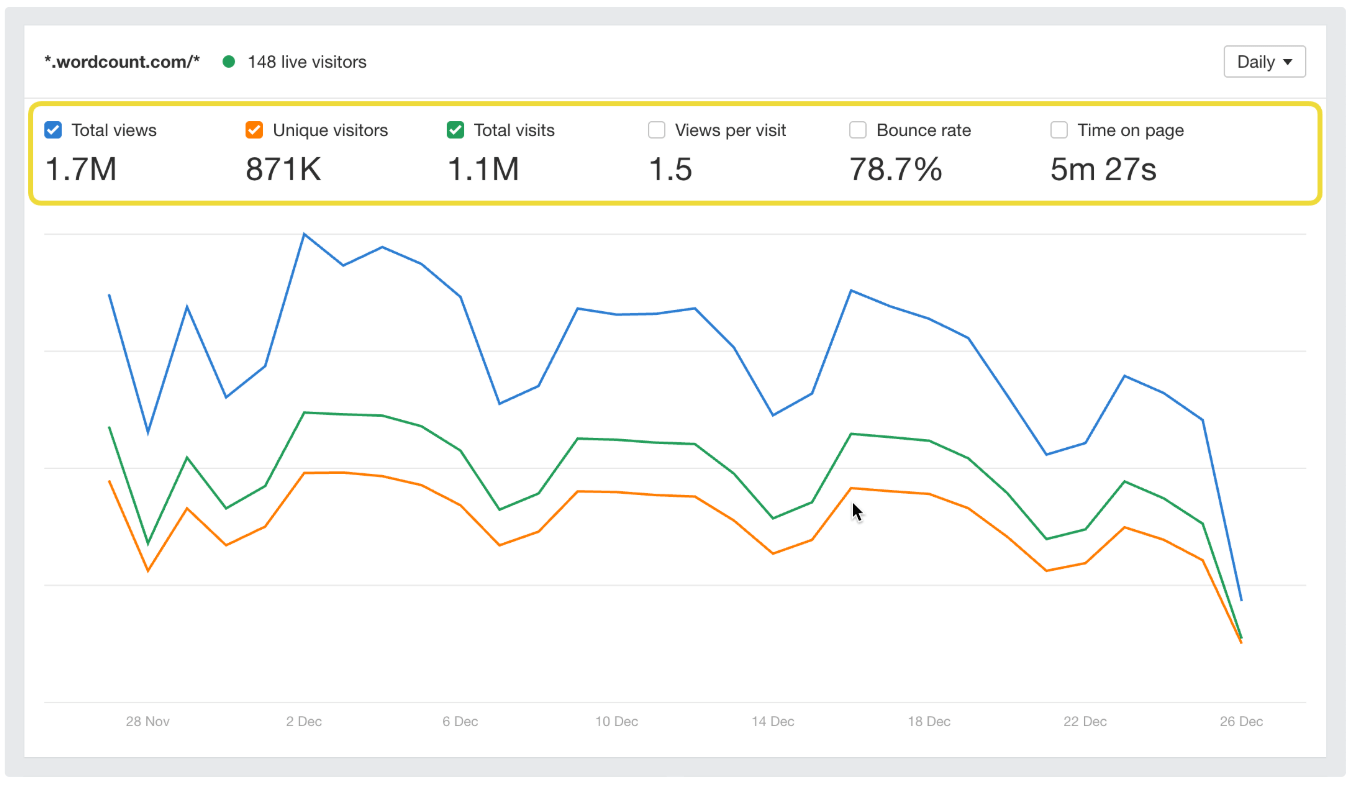
It may sound basic, but you simply need to write content, spread it, and gain traction in the early stages.
Once you get to that stage, it’s wise to switch to measuring a more robust KPI like your organic share of voice. This tells you how visible your brand is in organic search relative to the competition.
You can get a sense of your organic share of voice using Rank Tracker:
- Add the keywords you want to rank for
- Add your competitors
- Go to the Competitors Overview report
- Check your Visibility
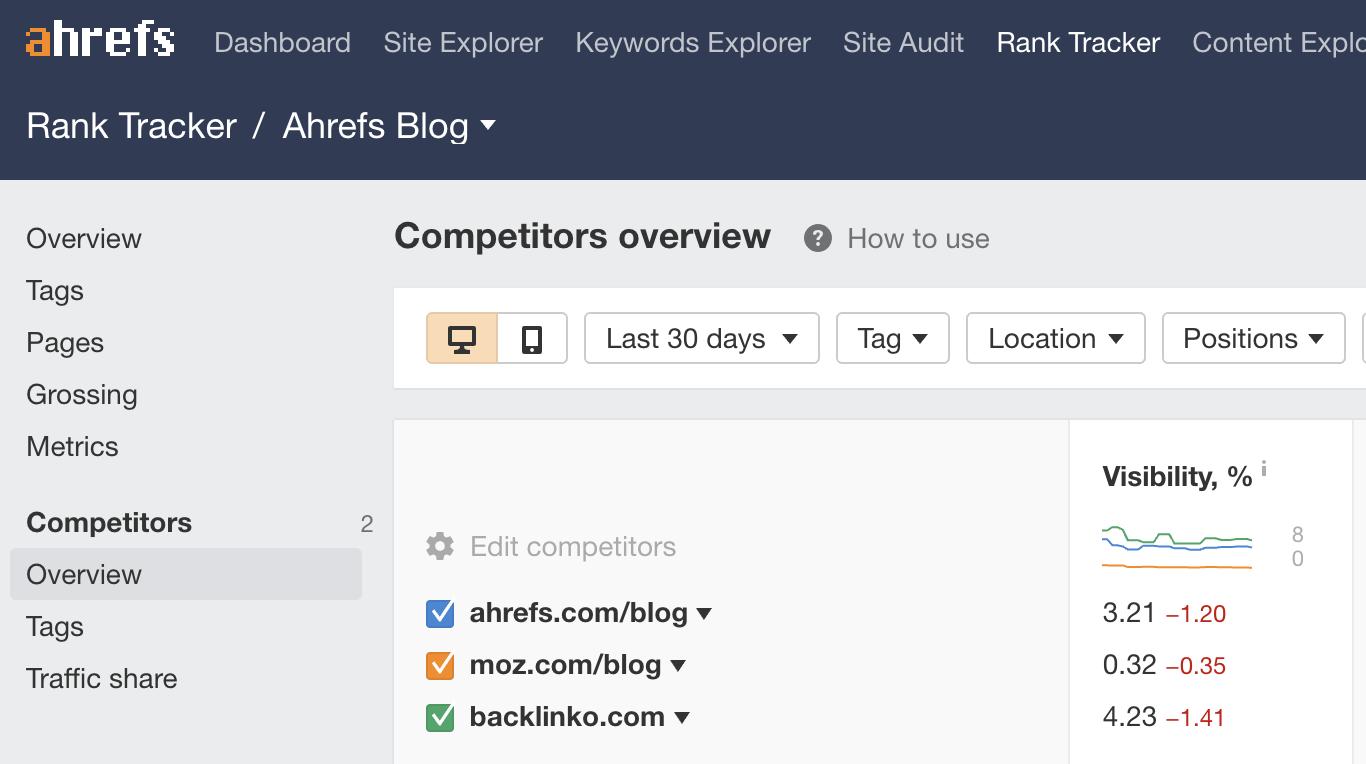
You want this to be increasing relative to your competitors over time.
Final thoughts
Building a winning blog content strategy takes time and effort, but it’s worth it. If you’re getting into blogging, you should be in it for the long haul. You won’t see results straight away, but with the help of Ahrefs and this tutorial, you’ll build a quality blog that will bear fruit in the form of more eyeballs and customers your way.
PS: If you hear people say: “Do people still read? …Isn’t the blog dead?” Don’t listen. As long as people are still searching for information on search engines, blogging isn’t dead.



